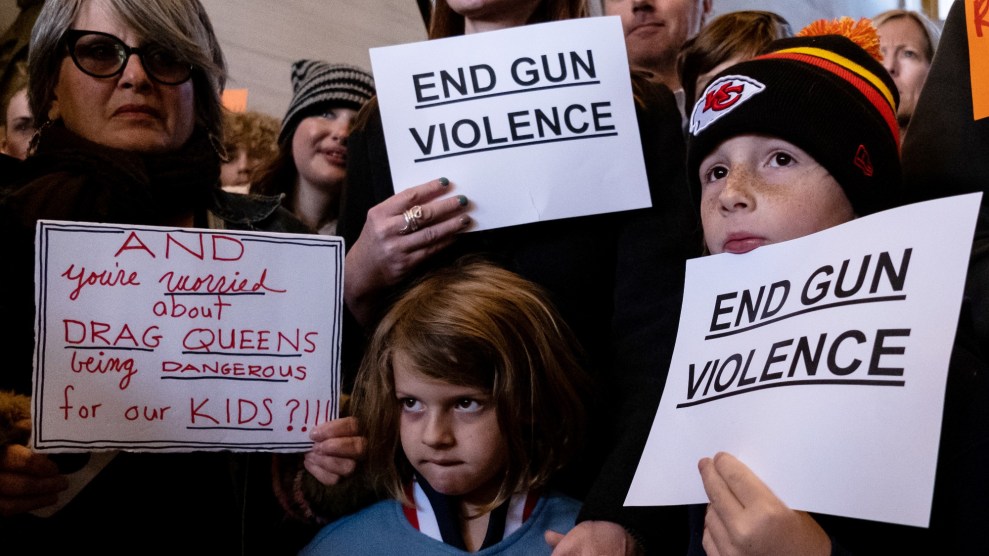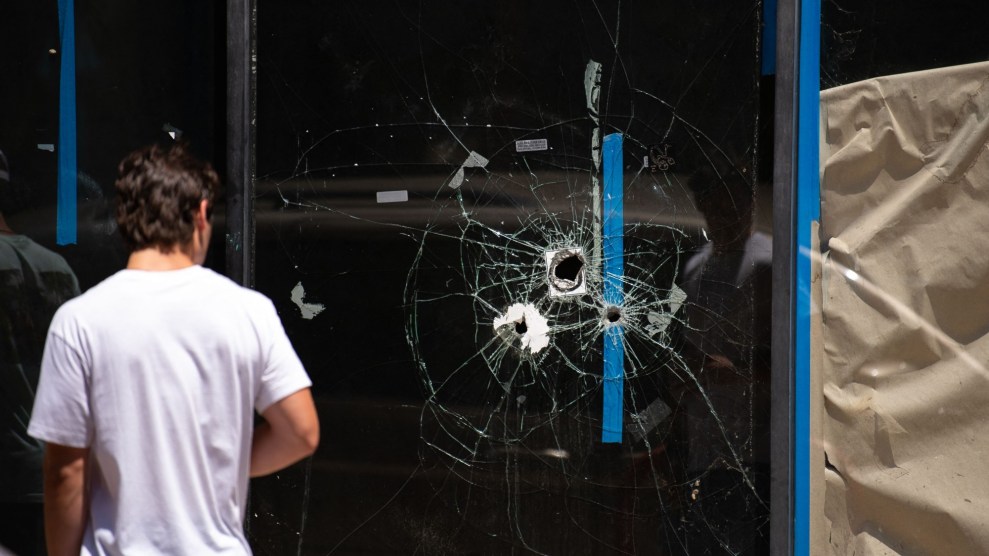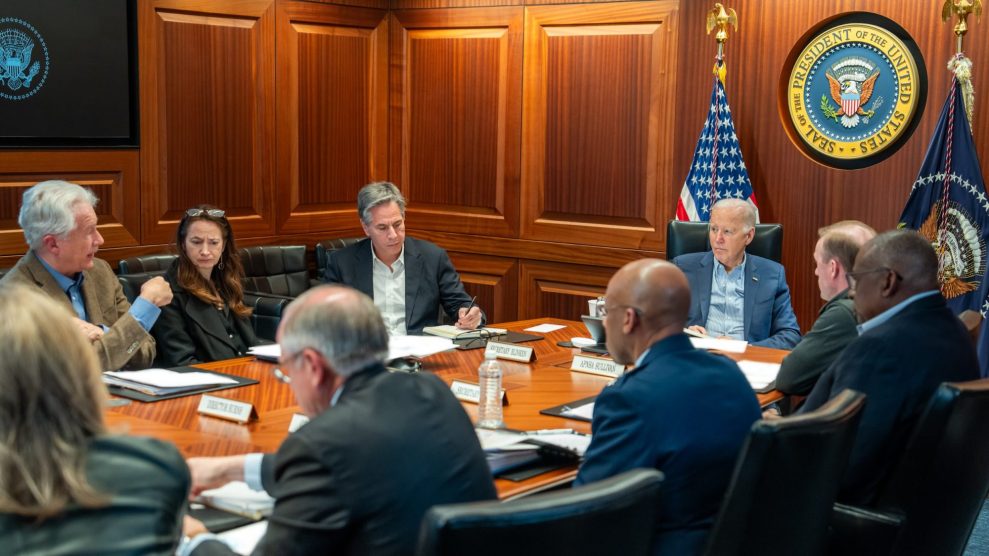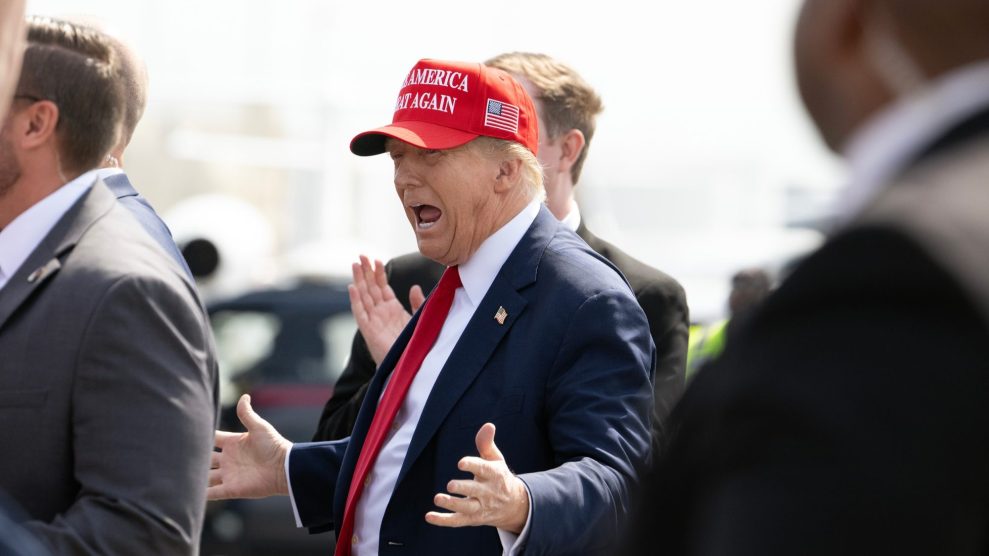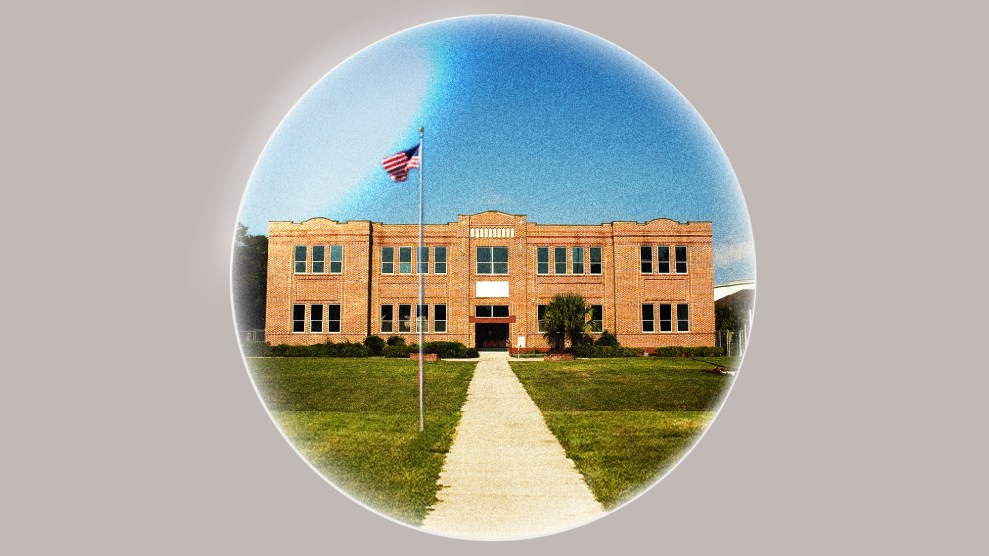
Mother Jones illustration; Getty
Last month, in the wake of the school shooting in Nashville that killed six people, Congressman Tim Burchett (R.-Tenn.) said in an interview that went viral, “If you think Washington is going to fix this problem, you’re wrong. They’re not going to fix this problem.” He added, “I don’t see any real role that we could do other than mess things up.” The reaction to his pessimism was swift—for progressives, his statement was further evidence that Republican lawmakers would always find excuses not to enact stricter gun control laws.
But when I read Rep. Burchett’s comments, I wondered why the conversation ended there. Even if this elected official, in whose state the latest gun violence involving children had just occurred, had flatly confirmed that gun control was a nonstarter in Congress, was there literally nothing else he could do to save the lives of children and others in schools?
It’s tough to argue with the progressive case for gun control: As long as people have easy access to weapons, the shootings will not stop, so let’s fix the root problem by enacting stricter firearm laws. But while our legislators have spent decades repeating the same arguments about Second Amendment rights over and over and over again, gun violence now has become the leading cause of death for American children. Guns kill more children than car accidents, cancer, and accidental poisoning. Yes, clearly we must work to reduce the number of guns in our communities, but aren’t there other available options to stop the carnage at schools—not only from mass shootings but also from other, much more common, gun-related violence?
Some good research has been done on threat assessment, a promising strategy to identify potential assailants before they act; my colleague Mark Follman has reported extensively and written a book on that approach. “After years of research into the origins and emerging work of threat assessment—which likely has prevented dozens, if not hundreds, of violent attacks throughout the country—I came to see that we could do far more as a society to reduce mass shootings,” he wrote in a recent piece on the topic. Meanwhile, there is some evidence that measures that adding more guns to campuses—by employing more school resource officers, for example, or arming teachers—are very bad ideas. Studies show that more guns don’t make people safer and that increased police presence at schools results in Black kids getting in trouble at twice the rate of their white counterparts.
But what about methods that don’t involve more guns—physical measures like metal detectors and bulletproof building materials, as well as preparation such as lockdown drills? Progressive groups are not wild about these either. The American Federation of Teachers, the National Education Association, and the gun control advocacy group Everytown for Gun Safety advocate against lockdown drills, arguing that they actually may do more harm than good, by increasing students’ feelings of anxiety and depression. Media coverage generally echoes that argument. The drills “may harm the mental health of students, while doing little to prevent mass shootings,” warned the New York Times in 2021. The $3 billion “school hardening” industry has also been widely criticized: “Hardening our schools implies hardening our hearts and minds, while we cede yet more power to security experts and police forces,” William Astore wrote in The Nation last year. In 2019, the Washington Post ran a story about a report that analyzed 89 studies on school hardening measures—like metal detectors, locked doors, and security cameras—and reported “no evidence” that any of the tactics studied were effective.
Yet the more I thought about that conclusion, the more I wondered how one could possibly prove that a given measure hadn’t prevented violence—if you install a metal detector, for example, there’s no way to know what might have happened had you not installed it. Indeed, many of the studies that the team looked at concerned perceptions of safety rather than evidence that some effort demonstrably increased the security of a particular location. These studies reflected interviews with or questionnaires given to staff and students about what measures they believed would make them safer.
I wanted to figure out whether it was actually possible to know whether certain approaches worked, so I called the study’s lead author, New Mexico State University public health professor Jagdish Khubchandani. In explaining his position on school hardening to me, he used the analogy of someone attempting to prevent a heart attack. “Instead of eating healthy and exercising,” he said, “they’re stocking up on medication.” In the case of school violence, the effective preventative measures, he explained, would be limiting access to firearms in the first place, rather than relying on security measures to minimize the damage. Still, of the studies his team looked at, it was impossible to draw firm conclusions on any one measure because, he said, “there’s no true experiment here.”
He speculated that metal detectors, especially if schools ensure that there is only one entrance, “may help with stopping kids from bringing weapons to school.” That could be a big win since it’s estimated that a million kids bring guns to school every year. For mass shootings, though, he suspected metal detectors would likely be ineffective—an assailant could walk right through and start firing. Bulletproof glass, on the other hand, “may have a lot of value,” he said. “If you have a good, locked door that is bulletproof, the entry would be difficult.” That might have made a difference at Covenant School in Tennessee, where glass entrance doors were easily blasted open by the shooter.
Khubchandani recommended I reach out to another school violence expert, Jaclyn Schildkraut, the executive director of the Regional Gun Violence Research Consortium at the Rockefeller Institute of Government in Albany, New York. Unlike Khubchandani, she didn’t like the idea of metal detectors, extrapolating from their relatively low success rate at airports. In an email to me, she wrote that she saw bulletproof glass as “part of the security theater/consumer product industry that is getting schools to spend upwards of like $3 billion per year on things that are tangible, so it makes people feel better, despite a lack of evidence to support its efficacy.” Yet at the same time, she allowed that “It is virtually impossible to assess the efficacy of school security measures relative to the low base rate (numbers) of school shootings (mass shootings and otherwise).” She added, “It is also virtually impossible to prove a counterfactual—meaning that you can’t prove why something didn’t happen.” Which was exactly the problem that I had with the studies in the first place.
Surprisingly, despite overwhelmingly negative coverage in the media and by advocacy groups including Everytown for Gun Safety, lockdown drills were the one measure that Khubchandani and Schildkraut both endorsed. The research seems to support this. A 2017 study published in the Journal of Applied Behavior Analysis showed that even the youngest students—kindergartners—were able to successfully follow lockdown procedures after practicing through drills. Similarly, a 2020 study conducted by Schildkraut’s team showed that K-12 school staff and students became more efficient at lockdown procedures after going through training. As part of that same study, the team looked at 93 real-life school shootings. They found that schools that had succeeded in effectively locking down—which means classroom doors are locked with students and staff inside—saw 60 percent fewer casualties and 79 percent fewer deaths. In the most recent school shooting in Nashville, it’s quite possible that lockdown drills did save lives, as well-trained teachers barricaded themselves and their students in classrooms.
But aren’t lockdown drills themselves traumatic for kids? Critics claim that imagining such frightening scenarios only serves to make kids more anxious. As it turns out, many of the studies that are supposed to bolster this argument are themselves methodologically odd. For example, this one from 2015 analyzed how students felt after watching a video about how to stay safe in a school shooting, but it didn’t evaluate actual drills. An oft-cited 2021 study, commissioned by Everytown for Gun Safety and conducted by a team of researchers at the Georgia Institute of Technology, found, “Active shooter drills in schools are associated with increases in depression (39%), stress and anxiety (42%), and physiological health problems (23%).”
How do the researchers know this? Not from interviews, as it turns out, but from an algorithm that monitored all social media posts in a school community 90 days before and 90 days after an active shooter drill. The words that tripped the algorithm weren’t necessarily directly related to school shootings: for example, from increased mentions of “blood,” “pain,” “clinics,” and “pills,” researchers concluded that concerns over death had risen by 22 percent after a drill. Even some of the social media posts that the researchers highlighted as examples of psychological distress seemed questionable. One tweet—ostensibly from a parent in the community—read, “I hate that my adult children have so much anxiety. I wonder if ‘active shooter drills’ since kindergarten, have something to do with that?”
How is this evidence of anything but the fact that parents worry about their children’s worries, which we already knew? In fact, Schildkraut’s research shows that lockdown drills, when done with sensitivity (i.e. no fake blood or officers waving guns around) actually serve to alleviate children’s fears about shootings by giving them a sense of some control during a frightening situation. As one kindergartner put it in a 2018 Mother Jones piece about kids’ reactions to lockdown drills, “We curled up in the place in the back of the room. It was squished. Everyone was squished. We had to be squished because then if it happens for real, nothing will happen then.”
And while we’re on the subject of supposedly traumatic school safety tools: Though it’s often claimed that measures like metal detectors and surveillance cameras on children cause them psychological distress, it’s worth pointing out that many of the studies on this are from more than a decade ago, a bygone era when school shootings happened less frequently. Today, it’s all but impossible to protect students from the onslaught of grim news. The fetishization of the innocence of childhood—the obsession with shielding children from anything remotely upsetting—seems like just a slightly different flavor of the current effort by conservatives to ban books that tackle real-life tough topics like rape and slavery. If we had more frank, age-appropriate discussions with children about guns, perhaps they would grow up to be people who actually did something about them.
So, to review: Lockdowns work, and other measures, such as bulletproof glass and metal detectors, might work, but it’s hard to know. And there’s very little agreement on exactly how all these measures should be deployed. For example, 40 states require lockdown drills, but there is no federal guidance about how to conduct them, leaving individual school districts to fend for themselves with the limited resources they have. And despite so many “thoughts and prayers” and so many tragedies, research on school violence is still woefully underfunded. “In the last two, three decades, most of the researchers have been discouraged, and many actually left the field,” Khubchandani told me. “My adviser told me once that if you really want to be rich and famous, pursue obesity or HIV because there’s a lot of money there.”
By all means, let’s make it harder for violent people to get weapons in the first place. The United States is the only country in the world in which there are more guns than people. But the reality is that gun control isn’t going to happen—maybe ever, and certainly not soon—even as, let me reiterate, gun violence is now the number one killer of American children.
You can criticize the cost of school safety measures that we don’t have great evidence for, such as these bulletproof safe rooms for classrooms, starting at $50,000. But schools spend money on all sorts of stupid stuff, much of it far more expensive than reasonable security measures. Since the pandemic, many school districts have spent millions of dollars on ionizing air purification systems—there’s no evidence those work, and actually, scientists believe they could actually be dangerous. And don’t forget that every book that’s banned costs school districts upwards of $500. Meanwhile, this local North Carolina news broadcast mentions a company that says it can fortify existing doors for between $80 and $100 each.
I’m over living in a fantasy world where we prioritize a false cocoon of psychological safety over real-world preparations. To return to Khubchandani’s metaphor: The thing about lifestyle changes is that they won’t prevent heart disease if people refuse to diet and exercise—so it’s a good thing we have lifesaving medication. If our lawmakers can’t get their acts together to limit guns, why aren’t we using every possible tool we have to save our children’s lives?

